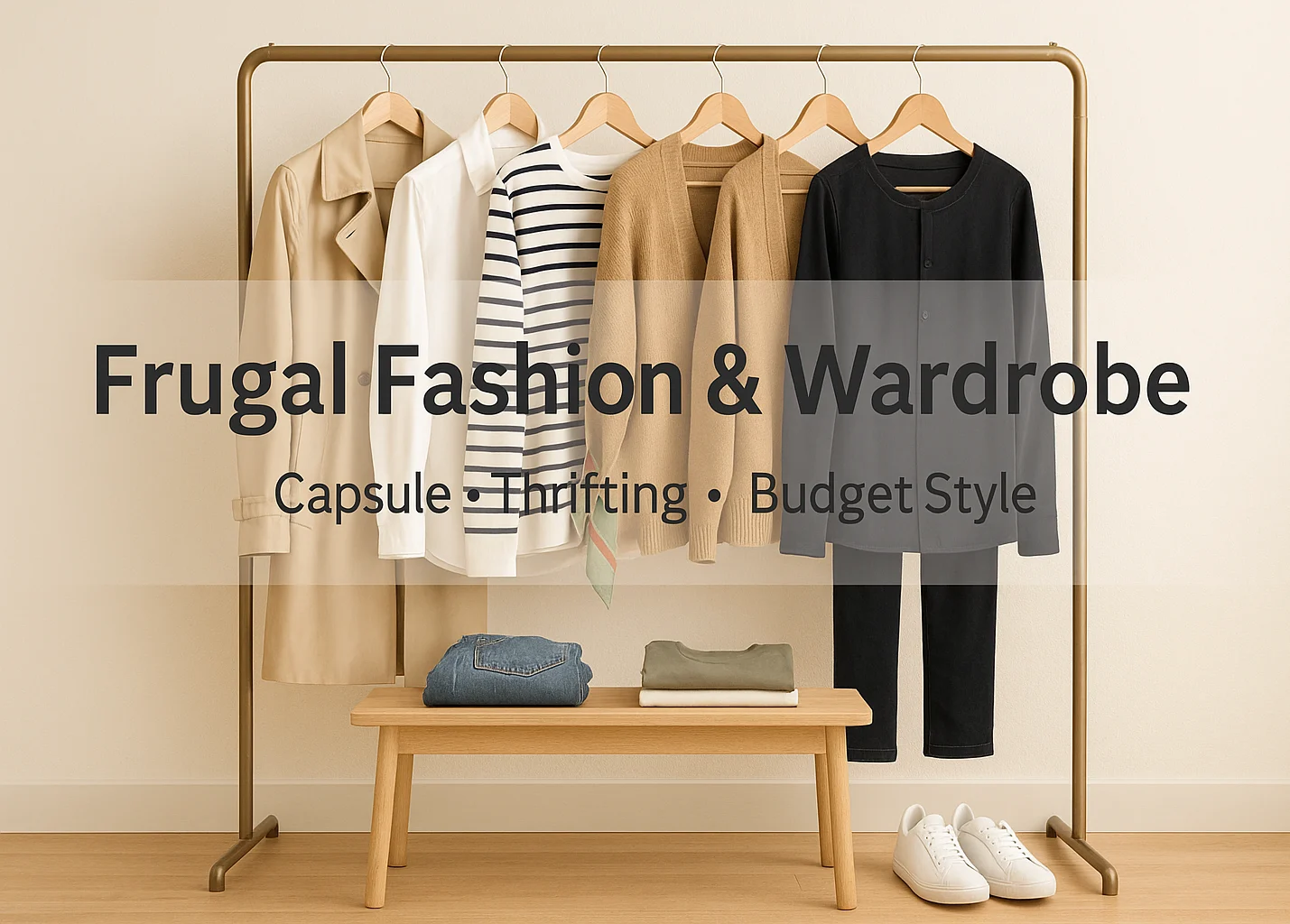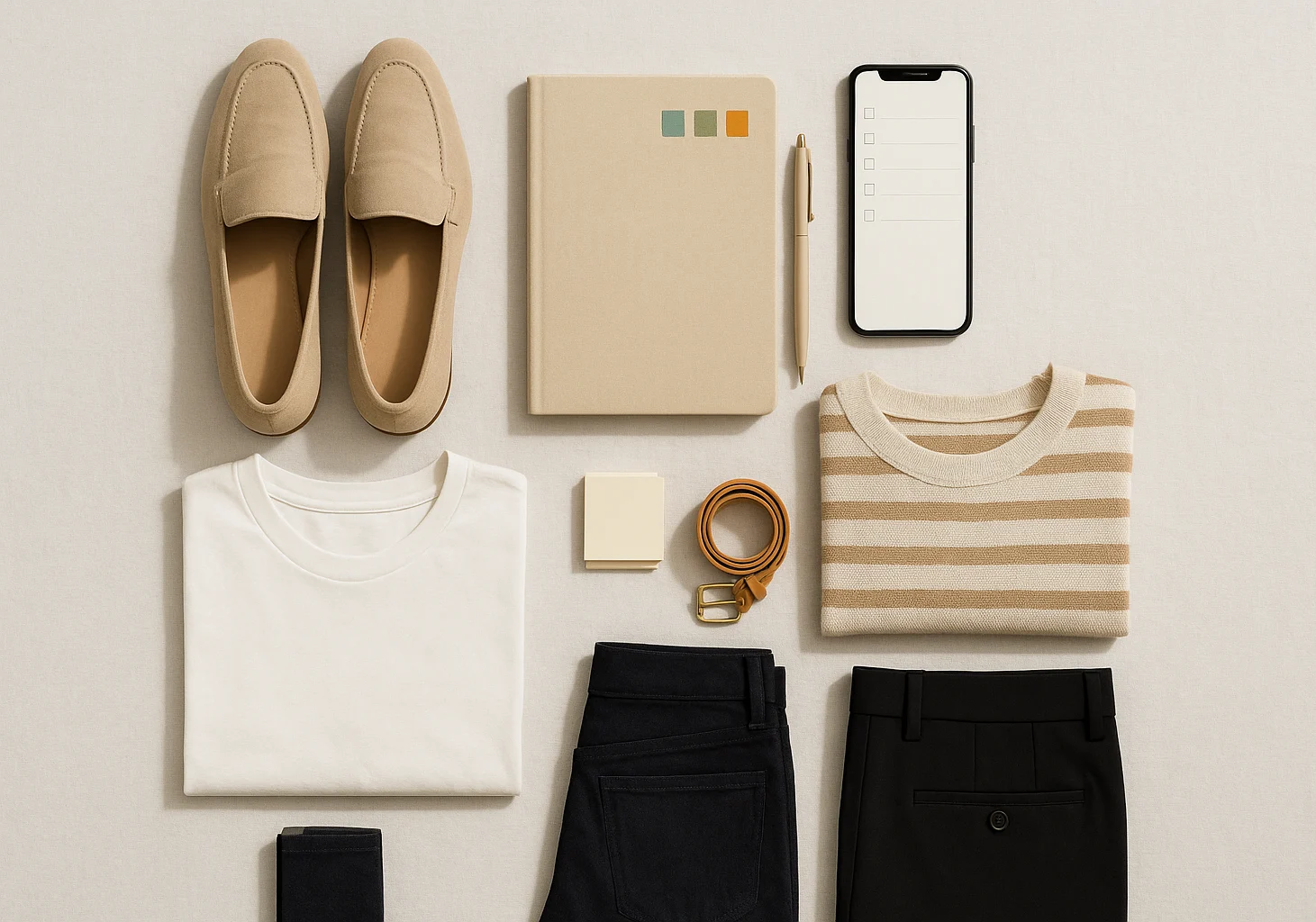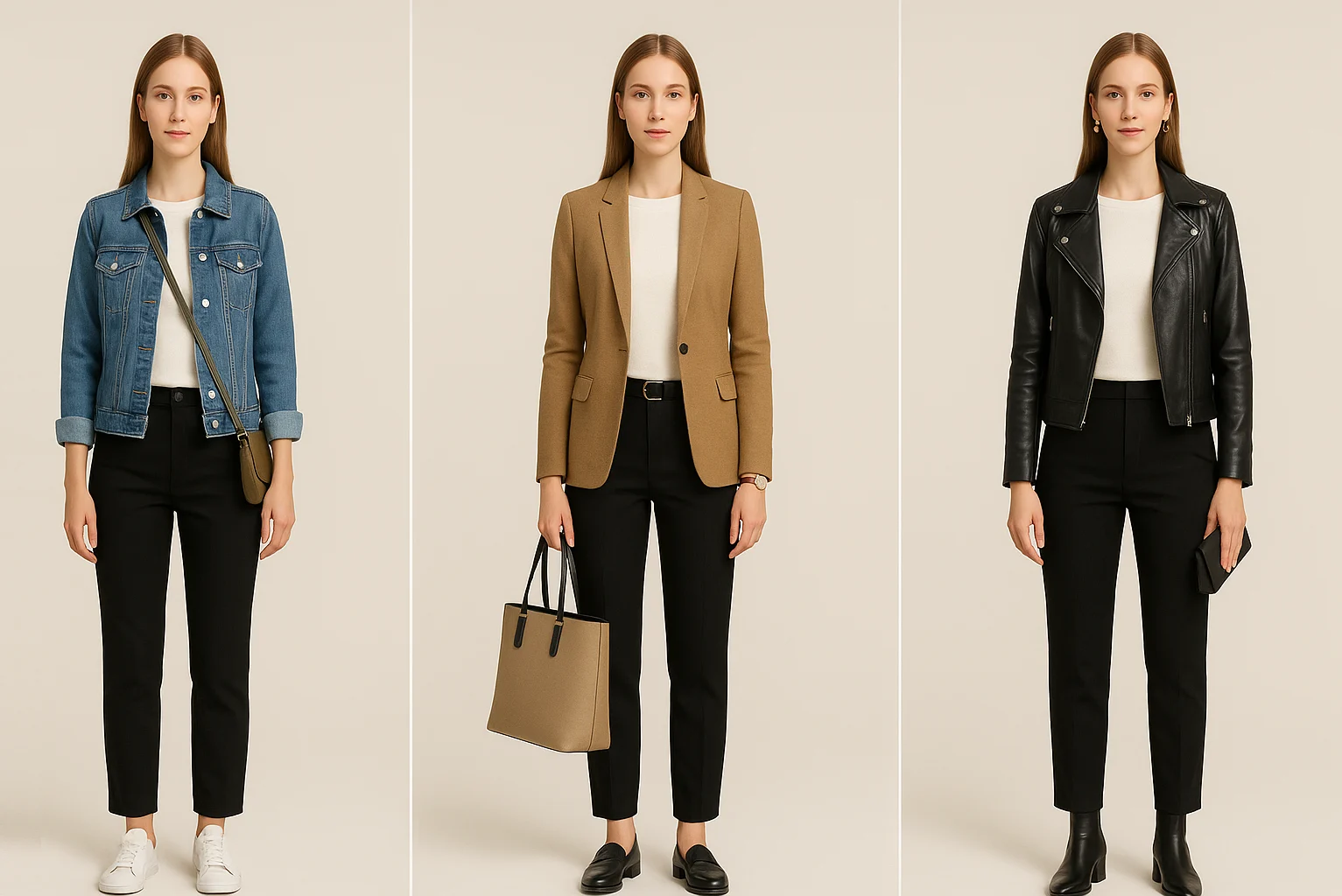
Staring at a full closet but feel like you’ve got nothing to wear? Frugal fashion can fix that. This guide shows you how to build an intentional capsule, shop smarter, and get more outfits from fewer pieces—without sacrificing personality or spending a fortune. Prefer color over neutrals? Love vintage? No problem. The point isn’t owning less; it’s owning what works.
Price-Per-Wear Calculator
Move the sliders to estimate true cost per wear. Results update instantly.
Your Cost Per Wear
$0.60 per wear — Good value. Keep or buy if it fills a real gap and pairs with 3–5 outfits you already own.
💡 Tip: Increase expected wears by planning outfits and noting 3 specific pairings before you buy.
Table of Contents
- What Is Frugal Fashion?
- Why Embrace a Frugal Approach to Style
- Dispelling the Myths
- The Foundation: Understanding Your Style DNA
- Build Your Capsule Wardrobe (Frugal at the Core)
- Quick Wardrobe Streamliner Checklist
- Smart Shopping Strategies (Spend Less, Look Better)
- Mastering the Art of Restyling & Reusing
- Beyond the Wardrobe: A Holistic Approach to Frugal Living & Style
- Frugal Fashion Budget Framework: The 4-Bucket Method
- Quality Check Like a Pro (Fabric • Fit • Finish)
- Thrifting Strategies & Tips: Where to Shop, What to Check & How to Clean Finds
- Clothing Repair & Simple Alterations (Hemming, Zippers, Patch Kits)
- DIY Clothing Upcycling: Turn “Meh” into “Wow”
- Minimalist Style, Frugal Mindset (How They Complement Each Other)
- Outfit Formulas Under $50 (Budget Style You Can Actually Find Secondhand)
- Laundry & Care That Extends Lifespan (and Saves Money)
- Resale & Rotation: When to Sell, Swap, or Donate
- The Art of Outfit Repeating (and Making It Invisible)
- Buy New vs Tailor vs Upcycle vs Let Go (Quick Decision Tree)
- Climate & Season Capsules (So Your Closet Matches Your Weather)
- Frequently Asked Questions
- Conclusion: Your Stylish & Sustainable Journey Begins Now!
Key Takeaways
- Embrace Intentionality: Choose versatile pieces that align with your personal style and lifestyle.
- Build a Capsule Wardrobe: Interchangeable items reduce decision fatigue and closet clutter while keeping budget style in focus.
- Shop Smart, Not Hard: Prioritize secondhand, sales, and ethical brands with a clear list.
- Master Restyling: Accessorize, layer, and mix-and-match for fresh looks without buying new.
- Think Sustainably: Care, repair, and buy thoughtfully to extend garment life.
What Is Frugal Fashion?
This approach means spending with intention: fewer, better pieces, smart secondhand finds, and habits that stretch every dollar—without losing your style. You’ll own less, wear more, shop with purpose, and lighten your footprint. Think: personal style first, trends second; quality basics that mix and match; and routines that make outfits easy.

Why Embrace a Frugal Approach to Style
Choosing frugal fashion helps cut costs and waste—and it fits neatly within sustainable fashion.
- Environmental impact: Fast fashion drives resource use and waste; buying less and choosing better helps.
- Financial freedom: Fewer impulse buys mean more money for goals that matter.
- Mental clarity: A streamlined closet reduces decision fatigue.
- Personal expression: Intentional pieces reflect your authentic style.
- Durability: Quality items last longer and hold shape better.
For U.S. data on textile generation and recovery, see the EPA’s textiles material-specific data.
Dispelling the Myths
Frugal doesn’t mean boring. If you love color, prints, or statement silhouettes, keep them—just make sure they’re versatile and true to your style. Accessories and texture add interest without extra clutter.
The Foundation: Understanding Your Style DNA
Define 3–5 style words, choose 2–3 neutrals and 2–4 accents, and assess your real-life needs (work, casual, active, occasions). Use what you wear most as your guide; let rarely worn items inform what to release.
Build Your Capsule Wardrobe (Frugal at the Core)
A budget-savvy wardrobe is a tight edit of interchangeable pieces. Aim for versatile, timeless, high-quality items that work across settings. Keep or adjust the count to your lifestyle; focus on function over a magic number.
- Bottoms: Dark jeans, tailored trousers, a versatile skirt.
- Tops: Quality tees, button-down, knit, and a dressier blouse.
- Dresses/Jumpsuits: One neutral day-to-night option.
- Outerwear: Blazer, trench or jacket, climate-ready coat.
- Shoes: Sneakers, flats/loafers, boots or heels.
Quick Wardrobe Streamliner Checklist
Skip the heavy embed. Do this instead: write 3 style words; pick neutrals and accents; count tops/bottoms/dresses/outerwear; list what you wear weekly; note 3 real gaps. Before buying, confirm 3–5 outfits with what you own and apply one-in-one-out. Repeat seasonally.
Smart Shopping Strategies (Spend Less, Look Better)
Smart shopping keeps your closet fresh without overspending.
- List first: Shop only for named gaps (fit, fabric, color).
- Quality over quantity: Check seams, fiber content, and finish.
- Secondhand smart: Thrift/consignment; know brands and measurements—these thrifting tips save time.
- Sales with intention: Buy classics, not maybes.
- Tip: Use the “3–5 outfits” rule before any purchase.
Mastering the Art of Restyling & Reusing
Accessories, layering, and mix-and-match turn a few staples into dozens of outfits. Document combos you love to build your personal lookbook for quick mornings.

Beyond the Wardrobe: A Holistic Approach to Frugal Living & Style
Caring well for what you own is the most frugal, sustainable move—it’s core to sustainable fashion. Wash less, mend early, store thoughtfully, and plan outfits with simple formulas.
Frugal Fashion Budget Framework: The 4-Bucket Method
To keep spending in check all year, split your clothing money into four buckets: Essentials (50%), Upgrades (20%), Secondhand Wins (20%), and Care/Repairs (10%). Essentials cover the workhorses you wear weekly. Upgrades fund strategic quality jumps—like thicker tees or lined trousers that last three times longer. Secondhand Wins bankroll consignment and thrift finds. Care/Repairs keeps items looking new with resoles, sweater shavers, and a tiny tailor fund.
| Bucket | % Allocation | Examples | Why it matters |
|---|---|---|---|
| Essentials | 50% | Workhorse denim, tees, underwear, socks | Frequent wear = lowest cost per wear |
| Upgrades | 20% | Lined trousers, leather belt, quality knit | Strategic quality bumps extend lifespan |
| Secondhand Wins | 20% | Consignment blazer, denim jacket, boots | Premium pieces at lower prices |
| Care/Repairs | 10% | Resoles, mending, sweater shaver | Maintains look & performance |
Test the split for three months. If you constantly raid “Care,” you’re underinvesting in maintenance. If “Upgrades” sits untouched, move that slice to Secondhand Wins and hunt for a blazer, denim jacket, or leather belt that elevates everything.
Quality Check Like a Pro (Fabric • Fit • Finish)
Run a 30-second scan before you buy. Fabric: favor dense cotton, linen, wool, or blends with minimal stretch (<5%). Hold to light—can you see your hand through it? That hints at low density. Fit: sit, reach, walk; seams shouldn’t pull and sleeves shouldn’t twist. Finish: inspect stress points, cross-stitched buttons, and smooth zippers.
Confirm care: can you wash cold and air-dry? If it requires dry cleaning, make sure it’s a true workhorse or special piece. If a garment fails two checks, skip it—even at 70% off.
Thrifting Strategies & Tips: Where to Shop, What to Check & How to Clean Finds
These thrifting tips help you rotate three circuits: a charity shop for random gems, a curated consignment store for workwear, and a “bins”/outlet stop for basics. Bring a micro-list (“dark straight jeans, camel belt, navy knit”) to avoid cart creep. In denim, scan hems and inner thighs; in knits, check elbows and cuffs; in outerwear, test lining tears and zipper teeth.
At home, de-label, de-scent, de-lint. Soak washable, colorfast pieces in cool water with a tablespoon of white vinegar (spot-test first and skip if care label advises against it), then cold wash and air-dry. For wool or delicate blends, freeze in a bag for 24 hours to help reduce odors—results vary—then steam. A sweater shaver and fabric comb rescue pilling fast.
Tip: Always follow care labels and spot-test for colorfastness before using vinegar, stain removers, or heat.
Want the full walkthrough? Dive into our thrifting strategies guide covering where to shop (including Goodwill), what to check, and how to clean finds.
Clothing Repair & Simple Alterations (Hemming, Zippers, Patch Kits)
A ten-minute fix can double an item’s life. For hems, mark the new length while wearing your shoes, press a crease, then use fusible hem tape or a clean running stitch. Zippers that stick often need graphite from a pencil or a drop of zipper lubricant—replace only if teeth are missing. Keep a mini kit: black/white thread, needles, small scissors, spare buttons, hem tape, iron-on patches.
If a repair costs more than half of replacement and the fabric is failing elsewhere, let it go. Otherwise, quick fixes are nearly always cheaper than buying new.
Tip: Unsure about hems, zippers, or adhesives? A quick visit to a local tailor can save the garment.
Learn step-by-steps in our clothing repair & simple alterations guide—hemming, zipper fixes, and patch kits included.
DIY Clothing Upcycling: Turn “Meh” into “Wow”
Try beginner-friendly diy clothing projects: men’s shirt → cropped wrap top (remove collar/cuffs, add side ties), maxi dress → two-piece set (cut at waist, elastic in skirt), or faded denim → tonal patchwork (reinforce from inside, then add a decorative patch). Keep the palette tight—two denims and a neutral thread—so it looks intentional, not crafty.
If you’re new to diy clothing, start with scrap fabric to practice seams and stitches.
Need more ideas? Browse our DIY clothing upcycling projects to transform old clothes into fresh styles.
Minimalist Style, Frugal Mindset (How They Complement Each Other)
Minimalism gives you limits; frugality gives you leverage. A small color palette and clear silhouettes let you invest in better fabric and keep a leaner closet that still feels rich. Use one-in-one-out and a 3–5 outfit test before buying. If a piece can’t star in multiple looks, it’s not a value buy—no matter the discount.
For a complete walkthrough, see our minimalist fashionista capsule wardrobe guide for styling on a budget.
Outfit Formulas Under $50 (Budget Style You Can Actually Find Secondhand)
These outfit formulas deliver budget style without sacrificing quality—fast to pull together and easy to repeat.
Smart-casual: dark straight jeans + striped knit + loafers. Work-polished: black trousers + silky blouse + thrifted blazer. Weekend: midi skirt + fitted tee + denim jacket + sneakers. Evening: black knit dress + statement earrings + sleek boots. Errands: leggings + oversized button-down + crossbody.
Set personal price caps (e.g., tops ≤ $15 secondhand) and let your price-per-wear estimate be the tiebreaker.
Laundry & Care That Extends Lifespan (and Saves Money)
Wash cold with a half-dose of detergent, and skip fabric softener—it coats fibers. Use mesh bags for knits and delicates; turn denim and tees inside out. Air-dry on hangers or a rack; lay sweaters flat to prevent stretch. A handheld steamer revives secondhand pieces and reduces dry-clean runs.
Store off-season clothes clean and dry in breathable bags. Odors and moths love dirt and moisture; a cedar block or lavender sachet is a cheap layer of protection.
Tip: Follow care labels, and spot-test detergents or stain removers on an inside seam before a full wash.
Resale & Rotation: When to Sell, Swap, or Donate
If you haven’t worn it in a season, try this order: friend swap → local consignment → list on apps → donate. For listings, shoot in daylight, include flat-lay and on-body photos, and write helpful titles: Brand • item • color • material • size • condition. Start at 60–70% of retail for like-new, 40–50% for gently used.
Keep a simple “lessons learned” note (e.g., this brand runs small, this fabric pills) so every resale cycle sharpens future buys.
The Art of Outfit Repeating (and Making It Invisible)
Repeating outfits is a feature, not a fail. Build signature bases—say, black trousers + white knit—and rotate the vibe with shoes, belts, and layers. Change just two elements (sneakers → loafers, tote → crossbody) and it reads as a new look, even in photos.
Keep a 10-outfit lookbook on your phone for rushed mornings; you’ll repeat confidently and buy less.
Buy New vs Tailor vs Upcycle vs Let Go (Quick Decision Tree)
Fit fixable in one step? Tailor (waist nip, hem, sleeve shorten). Fabric tired but sturdy? Dye, re-button, or upcycle. Comfort or fabric fails? Let go. Special piece that solves 3+ outfits? Consider new—but check cost per wear first.
If you’re hesitating after the flow, it’s a “no for now.” Your budget will thank you.
Climate & Season Capsules (So Your Closet Matches Your Weather)
Anchor the year around two cores: warm-weather and cool-weather. Each gets ~20–30 pieces with five cross-season heroes—denim jacket, trench, ankle boots, white sneakers, mid-weight knit. In hot, humid climates favor breathable weaves and light colors; in cold zones prioritize wool, lined trousers, heat-tech layers, and water-resistant outerwear.
Keep the color story consistent so pieces migrate between seasons smoothly. That’s how a small closet behaves like a big one.
Frequently Asked Questions
Conclusion: Your Stylish & Sustainable Journey Begins Now!
You don’t need more clothes—you need the right ones. Start small: edit one drawer, define your palette, make a short gap list, and build from there. Consistency beats overhaul.
This frugal fashion guide is for general education and inspiration—not financial, legal, or professional garment-care advice. Always follow care labels and consult a qualified tailor or cleaner when needed.